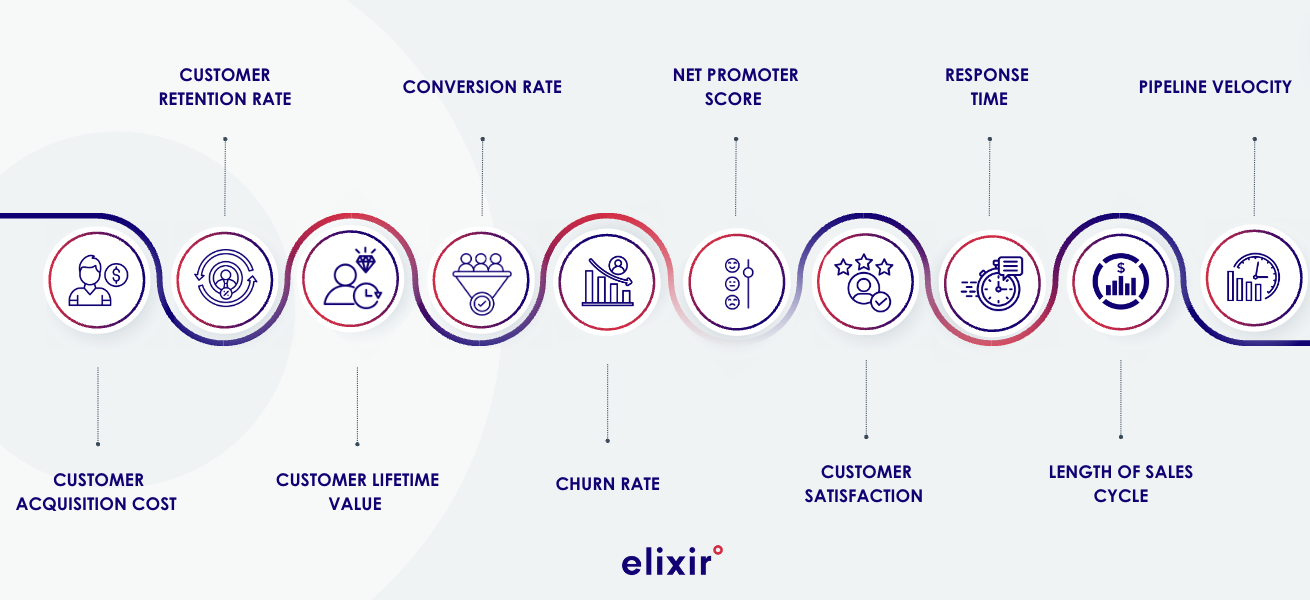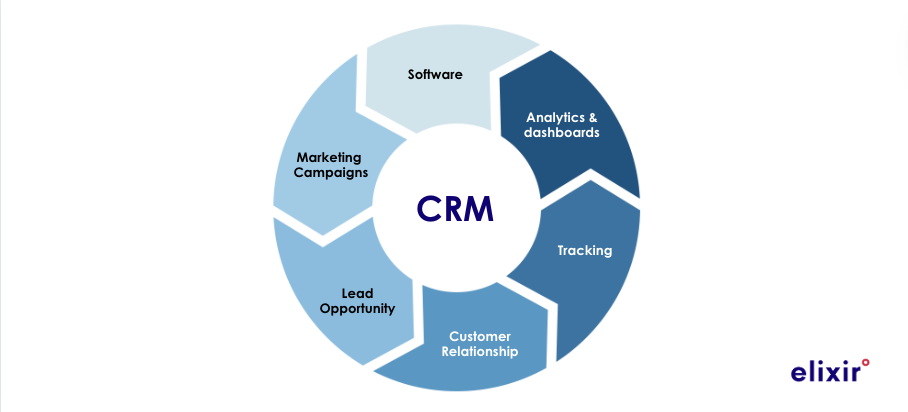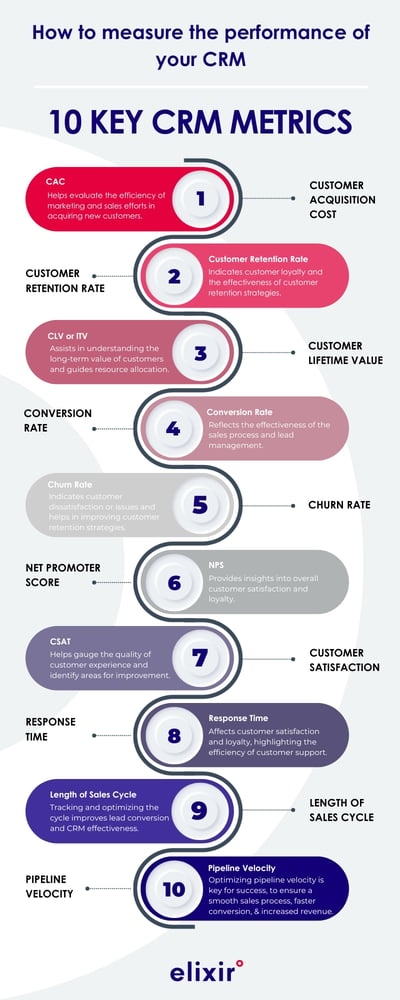Defining CRM metrics: How to measure your CRM performance (upd. 2024)

You've dedicated significant time and resources to your CRM, but how can you determine if it's truly impacting your business? Fortunately, there are numerous metrics that can be analyzed to assess the effectiveness of your CRM and gain valuable insights into areas that can be improved. We have compiled a comprehensive list of 10 essential metrics that can be easily tracked within HubSpot to assess the effectiveness of your CRM.
Transform Your Business: Start Implementing CRM Solutions! Let's connect.

What is CRM performance?
At its core, CRM performance is the comprehensive evaluation of how well an organization's CRM system aligns with its overarching objectives. It scrutinizes the nuanced interplay between technology, customer satisfaction, and revenue generation. In the professional sphere, CRM performance serves as the pulse of customer-centric initiatives, where data-driven precision becomes the cornerstone of strategic decision-making.
Curious to explore further about successful CRM implementations? Delve into the roadmap and unlock valuable insights that will guide you towards achieving CRM success.
WHY DO WE MEASURE THE PERFORMANCE OF CRM?
Measuring the performance of your CRM system is crucial for the success of your business. It allows you to evaluate the effectiveness of your CRM implementation and identify areas for improvement.
> By measuring specific metrics,
you can gain valuable insights into the impact of your CRM on various aspects of your business.
Another important reason for measuring CRM performance is to track the return on investment (ROI) of your CRM implementation.
> By analyzing key performance indicators (KPIs),
you can determine the value and impact of your CRM system on revenue generation and customer satisfaction.
The Foundation: 10 Key CRM Metrics to track
1. Customer Acquisition Cost (CAC)
-
Definition: The total cost incurred to acquire a new customer.
- Importance: Helps evaluate the efficiency of marketing and sales efforts in acquiring new customers.
> Utilize HubSpot's analytics tools to track the cost associated with acquiring new customers. Leverage its reporting features to gain insights into the efficiency of your marketing and sales efforts.
2. Customer Retention Rate
-
Definition: The percentage of customers a business retains over a specific period.
- Importance: Indicates customer loyalty and the effectiveness of customer retention strategies.
3. Customer Lifetime Value (CLV or lTV)
-
Definition: The predicted net profit attributed to the entire future relationship with a customer.
- Importance: Assists in understanding the long-term value of customers and guides resource allocation.
4. Conversion Rate
-
Definition: The percentage of leads or prospects that convert into paying customers.
- Importance: Reflects the effectiveness of the sales process and lead management.
> Leverage HubSpot's sales analytics and reporting tools to track conversion rates. Monitor the percentage of leads or prospects that convert into paying customers, gaining insights into the effectiveness of your sales process.
5. Churn Rate
-
Definition: The percentage of customers who stop using a product or service over a given period.
- Importance: Indicates customer dissatisfaction or issues and helps in improving customer retention strategies.
6. Net Promoter Score (NPS)
-
Definition: Measures the likelihood of customers recommending a company's product or service.
- Importance: Provides insights into overall customer satisfaction and loyalty.
7. Customer Satisfaction (CSAT)
-
Definition: Measures customer satisfaction with a product, service, or interaction.
- Importance: Helps gauge the quality of customer experience and identify areas for improvement.
> Leverage HubSpot's customer feedback tools to measure satisfaction with products, services, or interactions. Analyze CSAT scores within HubSpot to identify areas for improvement in the customer experience.
8. Response Time
-
Definition: The average time taken to respond to customer inquiries or support requests.
- Importance: Affects customer satisfaction and loyalty, highlighting the efficiency of customer support.
9. Length of Sales Cycle
-
Definition: The average duration it takes for a lead to move from the initial contact stage to becoming a paying customer.
- Importance: The length of the sales cycle is crucial for evaluating CRM performance. Tracking and optimizing the cycle improves lead conversion and CRM effectiveness.
10. Pipeline Velocity
-
Definition: Pipeline velocity measures the speed of leads through the sales pipeline, indicating sales process efficiency. It is calculated by dividing closed deals by the average time in the pipeline.
- Importance: Optimizing pipeline velocity is essential for success, as it ensures a smooth sales process, faster conversion, and increased revenue.
> Leverage HubSpot's sales automation and pipeline management tools to measure pipeline velocity. Calculate it by dividing closed deals by the average time in the pipeline, optimizing sales efficiency and accelerating revenue generation.

Selecting the Right CRM Metrics for Your Business
-
Aligning Metrics with Business Goals: Ensure chosen metrics directly contribute to overarching business objectives, fostering a strategic approach to customer relationship management.
-
Customizing Metrics Based on Industry: Tailor metrics to the specific challenges and opportunities within each industry, ensuring relevance and accuracy in performance evaluation.
-
Balancing Short-term and Long-term Metrics: Strive for a comprehensive view of customer relationships by balancing immediate impact metrics with those indicative of sustained success. This approach enables businesses to adapt dynamically to evolving market conditions.
Navigating CRM Optimization: Metrics, Strategies, and Business Growth
In conclusion, optimizing CRM performance is pivotal for businesses. The highlighted CRM metrics, from acquisition cost to pipeline velocity, underscore the intricate link between technology, customer satisfaction, and revenue. Aligning metrics with business goals and customizing them based on industry nuances ensures a strategic and adaptive approach. As businesses delve into CRM optimization, this guide serves as a roadmap for fostering stronger customer relationships and driving sustained growth.
Want to explore the possibilities? Let's Connect!
